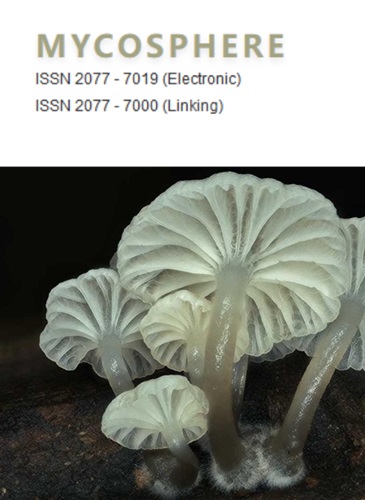大孢子虫的系统发育。茯苓科及其近属:新属、新种和新组合
IF 15.1
1区 生物学
Q1 MYCOLOGY
引用次数: 3
摘要
在二孢子门和大孢子门中发现了几种具有糊精状骨架菌丝和圆柱形薄壁担子孢子的复旋孢子多孢子科植物。在该属的系统发育中包含了DNA序列,其中大部分来自中国材料,从而识别出新属,即Megasporoporiella和Megasporia。本研究将Jorgewrightia和Mariorajchenbergia作为水草科植物的新属,分析了它们的4个基因区:ncrdna ITS1-5.8S-ITS (ITS)和部分大亚基(28S)、翻译延伸因子1- α (TEF1)和RNA聚合酶II第二大亚基(RPB2),这些基因区主要来自巴西材料。这些新属目前容纳了以前属于Cerioporus、Dichomitus、Megasporia、Megasporoporiella和Pachykytospora的物种。二分土、Jorgewrightia、Mariorajchenbergia、Megasporia和Megasporoporia主要有复生的浅色担子孢子、多孔膜孢子、通常为糊精状分枝的骨架菌丝和圆柱形担子孢子。这些属很难单独从形态学上进行区分,需要基于至少两个区域(ITS和28S)的序列分析以及地理分布信息来区分它们。大孢子虫(Megasporia variabilicolosa)和新孢子虫(Megasporoporia nesetulosa)被描述为新种,并提出了1个新型和20个新组合。给出了包括5属27种特征在内的分类表。本文章由计算机程序翻译,如有差异,请以英文原文为准。
Phylogeny of Megasporoporia s.lat. and related genera of Poyporaceae: New genera, new species and new combinations
Several resupinate poroid Polyporaceae with dextrinoid skeletal hyphae and cylindrical, thinwalled basidiospores have been placed in Dichomitus and Megasporoporia. With the inclusion of DNA sequences, mostly from Chinese material, in the phylogeny of the genera, new genera were recognized, i.e., Megasporoporiella and Megasporia. In the current study, Jorgewrightia and Mariorajchenbergia are described as new genera in the Polyporaceae based on phylogenetic analyses of four gene regions: nuc rDNA ITS1-5.8S-ITS (ITS) and partial Large Subunit (28S), Translation Elongation Factor 1-alpha (TEF1), and RNA polymerase II second largest subunit (RPB2), mostly from Brazilian material. These new genera currently accommodate species formerly placed in Cerioporus, Dichomitus, Megasporia, Megasporoporiella and Pachykytospora. Dichomitus, Jorgewrightia, Mariorajchenbergia, Megasporia and Megasporoporia have mostly resupinate pale-colored basidiomata, poroid hymenophore, usually dextrinoid branched skeletal hyphae, and cylindrical basidiospores. These genera are difficult to differentiate on morphology alone and analyses based on sequences from at least two regions (ITS and 28S), as well as information about geographical distribution, are needed to separate them. Megasporia variabilicolor and Megasporoporia neosetulosa are described as new species, and one neotype and 20 new combinations are proposed. Synoptic tables including characteristics for 27 species from the five genera is presented.
求助全文
通过发布文献求助,成功后即可免费获取论文全文。
去求助
来源期刊

Mycosphere
MYCOLOGY-
CiteScore
30.00
自引率
8.20%
发文量
9
审稿时长
4 weeks
期刊介绍:
Mycosphere stands as an international, peer-reviewed journal committed to the rapid dissemination of high-quality papers on fungal biology. Embracing an open-access approach, Mycosphere serves as a dedicated platform for the mycology community, ensuring swift publication of their valuable contributions. All submitted manuscripts undergo a thorough peer-review process before acceptance, with authors retaining copyright.
Key highlights of Mycosphere's publication include:
- Peer-reviewed manuscripts and monographs
- Open access, fostering accessibility and dissemination of knowledge
- Swift turnaround, facilitating timely sharing of research findings
- For information regarding open access charges, refer to the instructions for authors
- Special volumes, offering a platform for thematic collections and focused contributions.
Mycosphere is dedicated to promoting the accessibility and advancement of fungal biology through its inclusive and efficient publishing process.
 求助内容:
求助内容: 应助结果提醒方式:
应助结果提醒方式:


